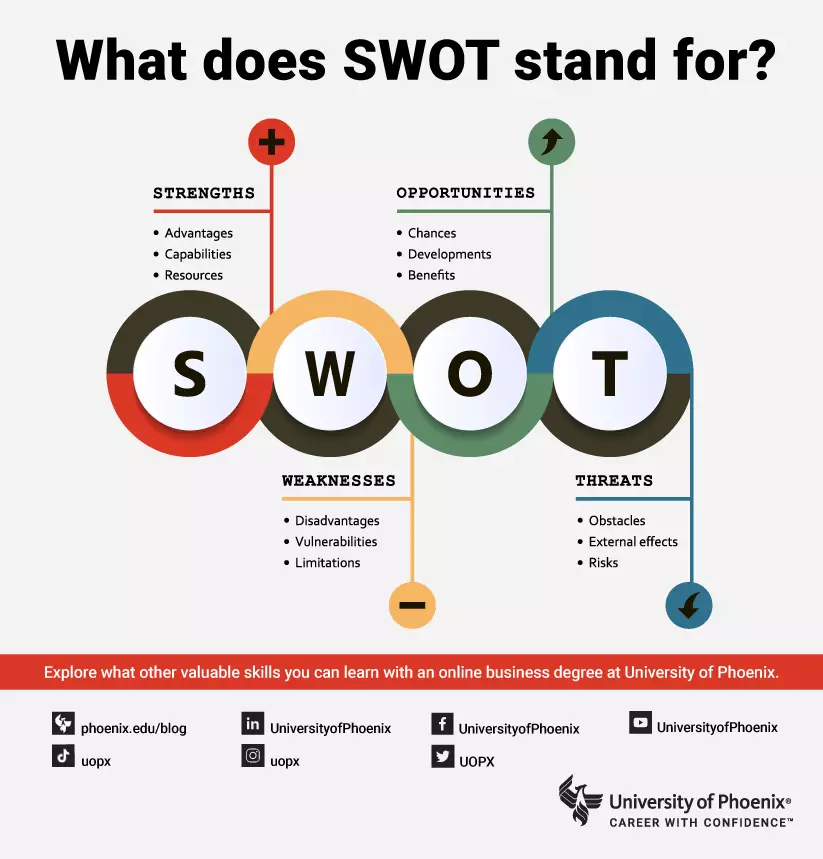How to use SWOT analysis

Written by Michael Feder

Reviewed by┬ĀKathryn Uhles, MIS, MSP,┬ĀDean, College of Business and IT

Mapping a path to success in any business or organization calls for effective strategies across all departments, from marketing and public relations to human resources and product development. Conducting a SWOT analysis is a common way to evaluate and implement those strategies.
What is a SWOT analysis?
A SWOT analysis assesses a company or organizationŌĆÖs current business model, identifies areas for improvement and evaluates potential opportunities or threats, both internal and external. SWOT analyses are fundamental in todayŌĆÖs ever-changing business landscape.┬ĀSWOT is an acronym for strengths, weaknesses, opportunities and threats.┬Ā
Strengths
The first step in a SWOT analysis is identifying a companyŌĆÖs strengths. These are the things that a company does well or that give it an advantage over other companies.
Examples of strengths might include:
- A strong brand name or reputation
- A loyal customer base
- A talented and experienced team
- A unique product or service
Take time to consider what makes the company unique and what sets it apart from the competition. If the analysis is being conducted by an internal team, they should then look at it from outsidersŌĆÖ perspective and consider what others might see as strengths.
A few crucial questions to ask are:
- What does the company do better than anyone else?
- What sets it apart from competition?
- How do customers see the company?
Weaknesses
The next step is identifying an organizationŌĆÖs weaknesses. These qualities or actions put a company at a┬Ācompetitive disadvantage┬Āor highlight an area in need of improvement. As with strengths, weaknesses can include processes, people or products.
This step may also involve looking at competitors. Investigate what competitors do well, how they differ and what their specific weaknesses are. From here, compare your organizationŌĆÖs weaknesses and how different approaches may impact consumer behavior.
Opportunities
In this step, identify areas for potential growth or improvement. This could include anything from a┬Āmarket shift to a new technology that could impact the industry. Therefore, itŌĆÖs essential to consider both long-term and short-term opportunities when conducting a SWOT analysis.
Examples of opportunities might include:
- A new trend in the industry
- An untapped market┬Āor customer base
- A change in regulation
The key to opportunity analysis is to be proactive and think about ways to take advantage of opportunities. Just because an opportunity exists doesnŌĆÖt mean the company will automatically benefit from it since competitors will be evaluating the same opportunities. Instead, target specific opportunities that align with strategic business goals and establish key performance indicators (KPIs), project plans and timelines that will help promote a tangible business advantage.
Of course, itŌĆÖs best to seize these opportunities wisely. When in doubt, lean toward evergreen tactics that will benefit the company for years to come instead of trends that have a limited time for the payoff.
Threats
The final step in a SWOT analysis is identifying external threats that could hurt the business. As with opportunities, consider long-term and short-term threats when brainstorming. These can┬Āinclude a new competitor entering the market, changes in consumer behavior, or even an economic recession.
Use this information to create a proactive plan to improve the organization and combat potential threats. This might involve developing new products, expanding into new markets or increasing marketing efforts. Whatever direction is decided, ensure that it aligns with the companyŌĆÖs strengths and that it will help reduce any weaknesses.
When is a SWOT analysis used?
A SWOT analysis is typically performed when an organization is seeking to optimize its overall business model. It can be performed by an internal management team or outsourced to a consultancy firm.
Once a comprehensive analysis is mapped out, itŌĆÖs presented to the organizationŌĆÖs senior management or board of directors. However, it can also be shared with other key stakeholders such as employees, suppliers and partners. Each stakeholder group will likely have different interests and needs, so itŌĆÖs important to tailor the SWOT analysis presentation accordingly.
Steps to set up a SWOT analysis
There is no single way to set up a SWOT analysis, and a variety of templates can be found online. The important thing is to ensure that all the relevant information is included and presented in a way thatŌĆÖs easy to understand.
1. Create a timeline
The first step is to decide on a time frame for the analysis. This can be short term (one or two years) or long term (three to five years) and will depend on the organizationŌĆÖs specific goals. Next, create a physical or digital timeline of the chosen time frameŌĆÖs start and end date.
This timeline will help determine what data needs to be gathered and who needs to be involved. For example, a long-term analysis will require more data and input from a broader range of people within the organization than a short-term analysis.
2. Track data
After the timeline is set, the next step is to gather relevant data. This might include financial reports, customer surveys, sales data and┬Ā. When gathering data, itŌĆÖs critical to track changes over time. This will help┬Āidentify patterns and trends┬Āthat might not be immediately obvious. For example, a sudden drop in sales might be due to a change in consumer behavior or a new competitor entering the market.
Data speaks volumes, so the more data gathered, the easier it will be to identify trends. However, track only the data relevant to the businessŌĆÖs goals. To help, consider using┬Ābusiness intelligence tools┬Āthat can automate data gathering and analysis.
3. Analyze collected data┬Ā
Once relevant data is collected, start analyzing it. The data gathered should help answer each of the four pillars of a SWOT analysis.
For instance, surveys might reveal that customers are unhappy with product quality, which would be a weakness. From there, you could┬Ālook for other threats (such as a competitor that creates better products) or opportunities (such as a new manufacturer that could produce higher-quality items).
After identifying the key elements of the companyŌĆÖs SWOT, start developing strategies for improvement. This is where to take the information from theSWOT analysis and use it to create a plan for moving forward. This might mean updating marketing strategies, improving manufacturing processes or doing something else altogether, depending on the industry and analysis results.
With its targeted mission and step-by-step execution, a SWOT analysis is an effective tool for optimizing business strategy and performance, no matter the industry.
│ó▒▓╣░∙▓į╠²more about SWOT analysis and other business decision-making tools
If you'r ready to learn more about┬Āconducting a SWOT analysis and other business decision-making processes, ░«╬█┤½├Į offers several┬Āonline business degrees,╠²Š▒▓į│”▒¶│▄╗ÕŠ▒▓į▓Ą╠²▓╣▓į associate degree program in business, a bachelorŌĆÖs program in business, and business management degree online.
Contact ░«╬█┤½├Į for more information.

ABOUT THE AUTHOR
A graduate of Johns Hopkins University and its Writing Seminars program and winner of the Stephen A. Dixon Literary Prize, Michael Feder brings an eye for detail and a passion for research to every article he writes. His academic and professional background includes experience in marketing, content development, script writing and SEO. Today, he works as a multimedia specialist at ░«╬█┤½├Į where he covers a variety of topics ranging from healthcare to IT.

ABOUT THE REVIEWER
Currently Dean of the College of Business and Information Technology,┬ĀKathryn Uhles has served ░«╬█┤½├Į in a variety of roles since 2006. Prior to joining ░«╬█┤½├Į, Kathryn taught fifth grade to underprivileged youth in ░«╬█┤½├Į.
This article has been vetted by ░«╬█┤½├Į's editorial advisory committee.┬Ā
Read more about our editorial process.






